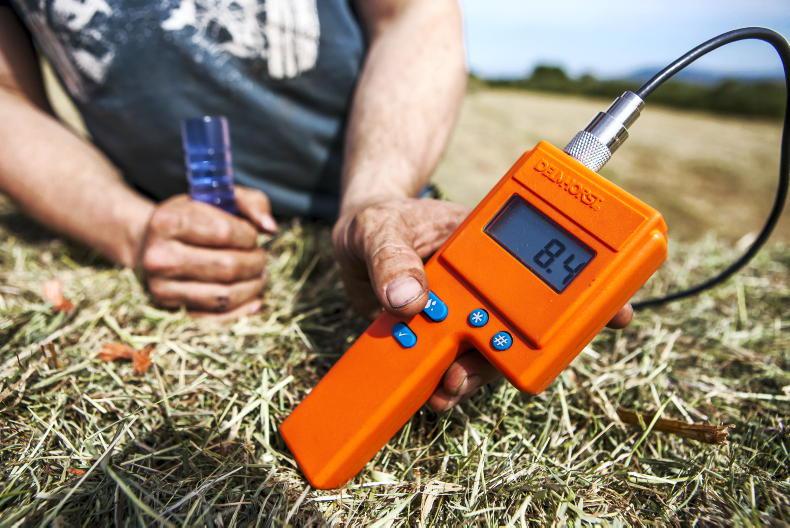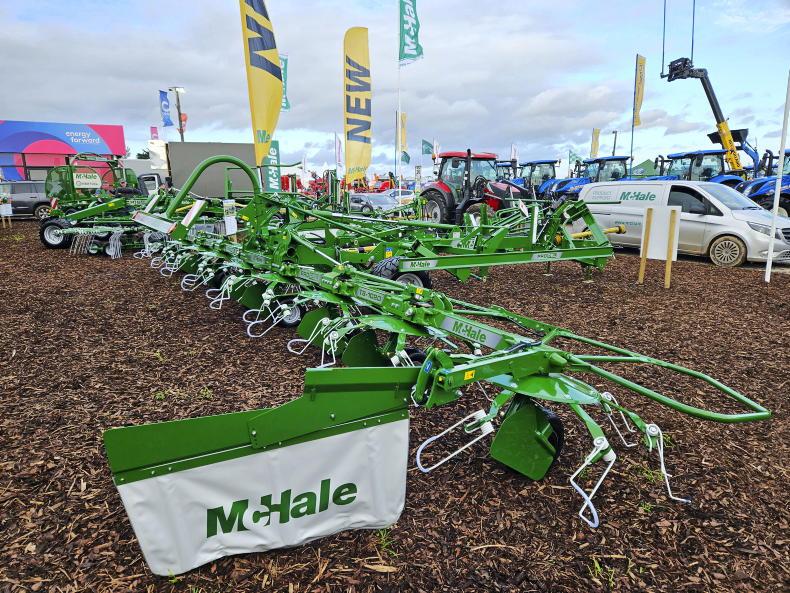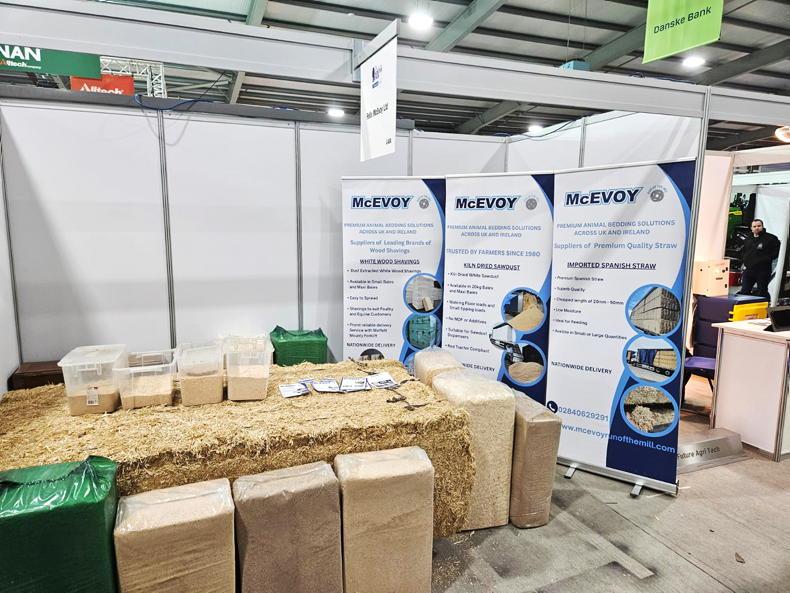The majority of this year’s winter crops were harvested and baled in very good conditions.
However, in the last two weeks in parts of the country, the weather situation has deteriorated significantly.
This has been more so in the west and north-west, but also into part of the midlands.
In these areas, some livestock are beginning to be housed, with dairy farmers in these regions now looking at housing cows by night, which we hope is a short- term fix.
Getting the corn cut is obviously the first hurdle, but with the high value of straw this year, farmers are trying their best to get it baled, and at as low of a moisture content as possible.
Everyone knows that straw is scarce at the minute, so all attempts are and will be made to get what is on the ground baled up and available to the market.
The one thing to keep in mind is that dry straw with bad colour is a more saleable and usable commodity than better coloured straw that is too high in moisture.
The most important thing when it comes to getting straw baled is waiting for the right weather.
The less moving of the straw that you can do, the more yield you will retain. I have heard people in the industry say that every time you handle straw, you can lose up to 7% of its yield.
Straw that is baled dry is worth waiting for. Naturally, if it’s baled too soon the higher moisture levels won’t allow the bales to be stored for any length of time before they begin to heat and stick together.
In this article, we take a look at the various pieces of machinery that farmers are using to help dry out wet straw.
Having the right gear obviously makes the job easier and quicker, but if the weather is on your side, it can be done with a simple hay bob.
Single-rotor rakes
and mergers
Both single rotor rakes and mergers work with the same principle of moving the straw onto dry ground. This is probably the simplest and most widely used method.
This method allows the full row of straw to be shifted on to dry ground, and allows the previously covered ground under the swath to dry out. Depending on how long the straw has been down, there may be regrowth coming up through the row. This wouldn’t be the case with any straw this year to date, but it’s one to be mindful of as the year progresses.
Green material
If this is the case, then something like a wuffler may be used to lift the straw up out of the green material before the straw is moved sideways, stopping the green material from becoming an issue. If straw is very wet, users of single-rotor rakes will tell you that these machines can knot the straw, or almost twist it up into a rope.
Although they are very expensive, the merger can be a better fit in this scenario. It lifts little to no stones, and creates a nice fluffy swarth. However, merger users will say that they bring their own challenges, such as struggling to get lighter straw off the belts fast enough. And they are very expensive pieces of equipment.
Using wufflers will tell you that if the straw isn’t sopping wet – and if the weather forecast is giving you a few days to work with, then one run of the wuffler to bring the damper straw from the bottom up to the top of the swath is a great job, and can be all that’s needed.
The only downfall with the wuffler is obviously that the straw is still landing on the same damp ground underneath the swath.

Whether you use a single rotor rake or a tedder, care should be taken to keep all machines up from the ground to reduce the risk of contaminating the straw with either clay or stones.
Tedders not for all headers
At this time of year and as the winter begins to close in, shorter days mean less drying.
So technically, the wider width that the row of straw can be spread across, the sooner the dampness can leave the surface of the straw.
Essentially, the better spread that you can get on the straw the sooner it will be ready to bale.
However, users of tedders in straw will tell you that these machines are ideal for headers of up to 15ft, and maybe 20ft depending on the yield.
Naturally by design, it’s only the centre rows of the tedders that come into contact with the majority of the straw, so you don’t get a full spreading effect across the width of the tedder like you would when working with for example 10ft rows of grass silage.
Stones
The other issue with spreading out straw, is that it will have to be raked up which means double handling, breaking down and losing more straw.
You are then introducing the potential challenge of gathering unwanted stones into the row.
Whether you use a single rotor rake or a tedder, care should be taken to keep all machines up from the ground to reduce the risk of contaminating the straw with either clay or stones, neither of which are beneficial additions.

Farmers will tell you that rule of thumb moisture levels of under 15% are acceptable for big square bales and possibly up to 18-19% in round bales.
Keeping the moisture levels right
With the high value of straw this year, no one wants bad straw, so judging whether it’s fit to bale or not is vital. Some will do this the old-fashioned way by touching and feeling it, with a crispy feel being desirable.
Others have moved on to the more technical method of using a moisture meter. If a meter is being used, farmers will tell you that rule of thumb moisture levels of under 15% are acceptable for big square bales and possibly up to 18-19% if you are making round bales.
Whether you are the end user of your own straw or you plan to sell it on the open market, it is vital that the moisture is low enough for it to be stored until it is needed for feeding or bedding animals over the winter period.
Remember, if you are in the east or southeast and sell straw to a dealer, it’s going to cost farmers up and down the west coast in the region of 20-35% more by the time haulage and margins are taken out of it, so it needs to be right. 
At this time of year, shorter days mean less drying, so technically, the wider width that the row of straw can be spread across, the sooner the dampness can leave the surface of the straw.

The only downfall with the wuffler is obviously that the straw is still landing on the same damp ground underneath the swath.
The majority of this year’s winter crops were harvested and baled in very good conditions.
However, in the last two weeks in parts of the country, the weather situation has deteriorated significantly.
This has been more so in the west and north-west, but also into part of the midlands.
In these areas, some livestock are beginning to be housed, with dairy farmers in these regions now looking at housing cows by night, which we hope is a short- term fix.
Getting the corn cut is obviously the first hurdle, but with the high value of straw this year, farmers are trying their best to get it baled, and at as low of a moisture content as possible.
Everyone knows that straw is scarce at the minute, so all attempts are and will be made to get what is on the ground baled up and available to the market.
The one thing to keep in mind is that dry straw with bad colour is a more saleable and usable commodity than better coloured straw that is too high in moisture.
The most important thing when it comes to getting straw baled is waiting for the right weather.
The less moving of the straw that you can do, the more yield you will retain. I have heard people in the industry say that every time you handle straw, you can lose up to 7% of its yield.
Straw that is baled dry is worth waiting for. Naturally, if it’s baled too soon the higher moisture levels won’t allow the bales to be stored for any length of time before they begin to heat and stick together.
In this article, we take a look at the various pieces of machinery that farmers are using to help dry out wet straw.
Having the right gear obviously makes the job easier and quicker, but if the weather is on your side, it can be done with a simple hay bob.
Single-rotor rakes
and mergers
Both single rotor rakes and mergers work with the same principle of moving the straw onto dry ground. This is probably the simplest and most widely used method.
This method allows the full row of straw to be shifted on to dry ground, and allows the previously covered ground under the swath to dry out. Depending on how long the straw has been down, there may be regrowth coming up through the row. This wouldn’t be the case with any straw this year to date, but it’s one to be mindful of as the year progresses.
Green material
If this is the case, then something like a wuffler may be used to lift the straw up out of the green material before the straw is moved sideways, stopping the green material from becoming an issue. If straw is very wet, users of single-rotor rakes will tell you that these machines can knot the straw, or almost twist it up into a rope.
Although they are very expensive, the merger can be a better fit in this scenario. It lifts little to no stones, and creates a nice fluffy swarth. However, merger users will say that they bring their own challenges, such as struggling to get lighter straw off the belts fast enough. And they are very expensive pieces of equipment.
Using wufflers will tell you that if the straw isn’t sopping wet – and if the weather forecast is giving you a few days to work with, then one run of the wuffler to bring the damper straw from the bottom up to the top of the swath is a great job, and can be all that’s needed.
The only downfall with the wuffler is obviously that the straw is still landing on the same damp ground underneath the swath.

Whether you use a single rotor rake or a tedder, care should be taken to keep all machines up from the ground to reduce the risk of contaminating the straw with either clay or stones.
Tedders not for all headers
At this time of year and as the winter begins to close in, shorter days mean less drying.
So technically, the wider width that the row of straw can be spread across, the sooner the dampness can leave the surface of the straw.
Essentially, the better spread that you can get on the straw the sooner it will be ready to bale.
However, users of tedders in straw will tell you that these machines are ideal for headers of up to 15ft, and maybe 20ft depending on the yield.
Naturally by design, it’s only the centre rows of the tedders that come into contact with the majority of the straw, so you don’t get a full spreading effect across the width of the tedder like you would when working with for example 10ft rows of grass silage.
Stones
The other issue with spreading out straw, is that it will have to be raked up which means double handling, breaking down and losing more straw.
You are then introducing the potential challenge of gathering unwanted stones into the row.
Whether you use a single rotor rake or a tedder, care should be taken to keep all machines up from the ground to reduce the risk of contaminating the straw with either clay or stones, neither of which are beneficial additions.

Farmers will tell you that rule of thumb moisture levels of under 15% are acceptable for big square bales and possibly up to 18-19% in round bales.
Keeping the moisture levels right
With the high value of straw this year, no one wants bad straw, so judging whether it’s fit to bale or not is vital. Some will do this the old-fashioned way by touching and feeling it, with a crispy feel being desirable.
Others have moved on to the more technical method of using a moisture meter. If a meter is being used, farmers will tell you that rule of thumb moisture levels of under 15% are acceptable for big square bales and possibly up to 18-19% if you are making round bales.
Whether you are the end user of your own straw or you plan to sell it on the open market, it is vital that the moisture is low enough for it to be stored until it is needed for feeding or bedding animals over the winter period.
Remember, if you are in the east or southeast and sell straw to a dealer, it’s going to cost farmers up and down the west coast in the region of 20-35% more by the time haulage and margins are taken out of it, so it needs to be right. 
At this time of year, shorter days mean less drying, so technically, the wider width that the row of straw can be spread across, the sooner the dampness can leave the surface of the straw.

The only downfall with the wuffler is obviously that the straw is still landing on the same damp ground underneath the swath.













SHARING OPTIONS